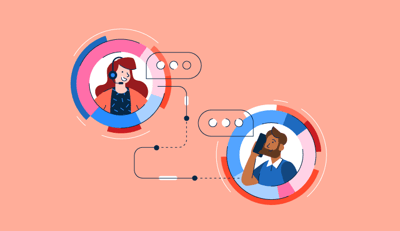July 12, 2024
 by Paul Schmidt / July 12, 2024
by Paul Schmidt / July 12, 2024

Customer expectations are at an all-time high.
Companies are moving away from a “growth at all costs” mentality to a smart and efficient growth mentality. With this shift, the focus on retaining customers, consistently adding incremental value (via proactive communication and planning), and delivering exceptional customer experiences has never been more critical.
With the reinvention of HubSpot Service Hub in 2024, HubSpot provides customer success teams with a comprehensive set of tools to help meet evolving customer needs.
Along with the existing set of ticketing, survey, automation, and reporting tools, HubSpot launched new:
Many customer success teams highlight the platform’s simplicity once configured. Check out G2 insights on HubSpot, its ease of use, and setup experience to understand how quickly teams go live after onboarding.
In this guide, we'll go through how companies progress through different phases of customer success maturity—react, define, manage, and optimize—and how specific HubSpot functionalities and tools can best support each phase.
We’ll also explore how Service Hub becomes even more valuable when combined with other Hubs in HubSpot.
An organization's customer success maturity grows as it moves from simply reacting to issues to proactively helping customers achieve their goals and find new ways to use its products.
The customer success maturity model framework helps companies evaluate their current strategies and plan for improvement. This model from HubSpot breaks customer success maturity into four main stages: react, define, manage, and optimize.
Source: HubSpot
In the react stage, customer success teams primarily respond to customer complaints and issues as they arise. At this level, interactions are mainly reactive, and customer success teams have minimal customer data to work with.
The focus is on addressing immediate needs and resolving issues promptly to maintain customer satisfaction.
In this stage, most commonly, a single customer success manager (CSM) or a team member wears multiple hats, such as of a salesperson, marketer, or IT person, and owns these responsibilities.
Key focus areas where HubSpot Service Hub can help:
AI integration: Use AI tools for ticket summarization and automated responses to common inquiries, which will help reduce response times and ensure consistent support.
Moving to the define stage, companies begin to structure and organize their customer success teams, defining individual roles within the support process. Goals and performance benchmarks are established to guide decisions and measure success.
The aim is to understand customer needs more deeply and start building proactive strategies.
In this stage, one or more CSMs typically own a certain customer segment. They may also manage the onboarding of new customers on top of handling customer inquiries.
Key focus areas where HubSpot Service Hub can help:
AI integration: Leverage AI to assist in writing knowledge base articles and analyze ticket data for common issues.
In the manage stage, customer success teams leverage data and insights to take proactive measures. This involves strategic engagement with customers, refining success strategies based on feedback, and using metrics to guide actions. The focus shifts from reactive problem solving to proactive customer engagement.
At this stage, there may be CSMs responsible for customers of varying complexity or customer lifetime value (CLTV).
Key focus areas where HubSpot Service Hub can help:
AI integration: Incorporate your own large language models (LLMs) into the customer success experience. These LLMs can leverage historical data to provide advanced capabilities, such as routing customers to sales or support depending on their needs.
For instance, if a customer inquiry suggests an upsell need, the LLM can seamlessly route the conversation to a sales rep.
Conversely, if the customer needs technical assistance, the LLM can route them to the appropriate support agent or provide immediate solutions.
At the optimize stage, delivering a five-star customer experience becomes a core business operation. Customer success efforts are fully integrated with other departments like sales and marketing, ensuring a unified approach to customer engagement and retention. The focus is on continuous improvement and optimizing every touchpoint in the customer journey.
In this stage, CSMs may see upsell and cross-sell as some of their primary responsibilities on top of retention. There will often be more in-depth documentation, systems and processes built out that allow for scalability.
Key focus areas where HubSpot Service Hub can help:
As your team progresses through these stages, HubSpot Service Hub provides the functionalities and tools needed to support each phase, ensuring your customer success efforts are both effective and scalable.
By understanding and utilizing the customer success maturity model, your company can systematically improve its customer success strategies, ultimately driving higher retention, satisfaction, and growth.
Looking for more options? Explore G2 guide on the best customer success software, all reviewed and rated by my colleague, Soundarya Jayaraman.
HubSpot’s biggest value is that all of your data is in one place.
This means less complexity, lower costs in building or maintaining integrations, and the ability for your entire company to have a 360-degree view of the customer. Many platforms promise this, but very few are actually able to accomplish this.
Integrating HubSpot Service Hub with other HubSpot Hubs—Marketing, Sales, Operations, Content, and Commerce—unlocks visibility and insights that enhance customer success efforts.
Customer success teams can deliver a personalized customer experience when they can easily see marketing, sales, operations, analytics, and customer support data all in one place.
By leveraging a 360-degree view of the customers based on data from each Hub, companies can create more effective strategies that mitigate churn, drive product usage, and increase upsell or cross-sell revenue.
Here are a few ways that other HubSpot Hubs benefit from an integration with Service Hub.
CSMs benefit when they have visibility into how the customer has engaged with various marketing touchpoints. A few benefits of the HubSpot Marketing Hub integration for organizations include:
When you're tracking all of your website and marketing campaigns in HubSpot, the customer marketing team can leverage data from existing clients to see if messaging and campaigns (targeted towards new customers) are resonating.
Further, customer marketing teams can then leverage targeted nurturing emails and custom audience-targeted ads to promote products to existing clients.
Sales and customer success teams benefit when their data lives in the same place. When HubSpot Sales Hub and Service Hub data are leveraged, CSMs can see if there are sales opportunities (aka deals) in flight. When CSMs see in-progress deals, they can work closely with the sales rep to help them best understand the customer goals, struggles, integrations, and team dynamics.
Vice versa, a sales rep working on a customer upsell benefits from seeing if there are tickets, recent surveys, or product usage data insights that would better inform follow-up conversations.
A common disconnect between sales and CSMs is when this data is not easily seen together, sales will be trying to work an opportunity when the customer is struggling and has outstanding unresolved support issues.
When the sales rep then reaches out, the customer often thinks the sales rep isn’t doing enough to help them solve their issues, and this leads to assumptions from the customer that that company is just trying to sell them more stuff vs. trying to help them solve their problems.
When a sales opportunity or deal data is physically adjacent to their ticketing data, this happens much less. On the other hand, if you are using a helpdesk outside of HubSpot, like Zendesk, the support data lives in one database and sales data lives in another. Unless your integration is well developed, there is an elevated risk of these disconnects happening. This is a common struggle HubSpot customers face when using third-party customer service tools.
Lastly, one of the most commonly used integrations between service and sales hub is deal management. If your CSMs are responsible for up-sells, then they will naturally use some of the deal functionality in the Sales Hub to create new deals and track those to close.
HubSpot Operations Hub, or Ops Hub, benefits organizations that are looking for integration, data partitioning for reporting, and highly customizable automation functionality. Here are a few use cases where customer success teams can benefit from Ops Hub:
With Operations Hub, CS teams are given a breadth of integration, reporting, and data quality features that will help them better connect the dots between the other major functional areas in their organization.
Content Hub is HubSpot’s content management system (CMS), as well as other content creation and hosting tools that can benefit customer success teams looking to drive increased product usage or engagement with customers. Here’s how integrating HubSpot CMS Hub with Service Hub can benefit customer success teams:
Most organizations primarily use their CMS as a tool for acquiring new customers, but in a world where growth needs to come from retention and upselling, your CMS unlocks tools that many of your competitors are likely barely exploring.
HubSpot Commerce Hub is a collection of tools for managing quotes, invoices, and payments. Here are a couple of ways that CS teams can leverage these tools within their organizations:
With the relaunch of Service Hub and its host of new features built for proactive support, customer success teams can derive huge benefits.
Integrating HubSpot Service Hub with other HubSpot Hubs provides a 360-degree view to every employee. This ultimately benefits the customer and gives your team the best fighting chance at retaining and hopefully growing existing customer relationships.
By advancing through the customer success maturity stages, teams can systematically enhance their CS processes, drive retention, and unlock new revenue growth opportunities.
Ready to harness HubSpot's full potential? Learn how to plan your implementation for maximum success.
Edited by Shanti S Nair
Paul Schmidt is the Director of Services Strategy at SmartBug Media. He oversees the agency's roadmap, partnerships and customer marketing initiatives. He previously worked at HubSpot leading over 200 implementations. He's based in Denver, CO, plays percussion, and holds an MBA from Suffolk.
HubSpot and NetSuite are two powerful names when you are looking for technology that can help...
 by Erika Josephison
by Erika Josephison
Running a small business means you’re juggling a dozen roles. Sales, operations, and support...
 by Sagar Joshi
by Sagar Joshi
HubSpot and NetSuite are two powerful names when you are looking for technology that can help...
 by Erika Josephison
by Erika Josephison



